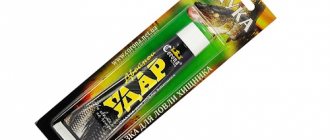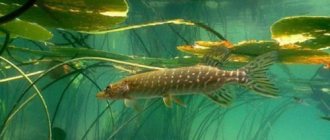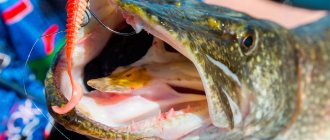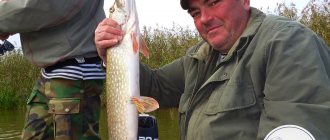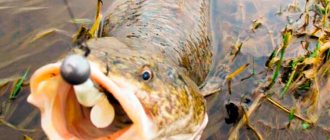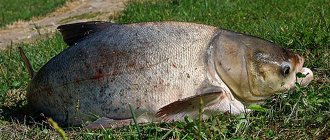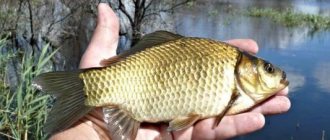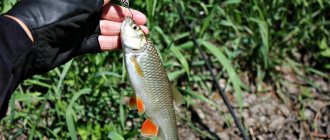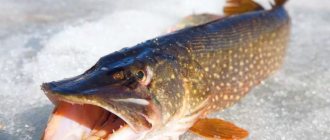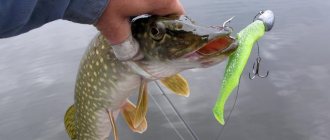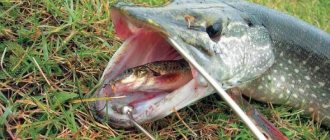In winter, all fish become inactive, and therefore go under the ice, where oxygen access is limited. But fishing for pike in January gives good results, since it does not particularly resist when fished. In this article you will learn where and how to fish and, more importantly, catch pike in the winter, in January, using a jig, spoon, and balancers.
Choosing a fishing spot
Fishing is generally dependent on the weather in any month of the year. You'll have to figure out when to catch pike and when not to.
- If the sky is cloudy, there is no wind and, on top of everything else, it’s snowing, this is the best time to catch a predator;
- On a frosty and sunny day, the fish is unlikely to swim out of its hole;
- During a north wind, fishing will not be successful.
Before fishing, you should always check the pond for the presence of fish. Usually the pike tries to stay in the pits throughout January, and leaves its place only during the period of hunger. And to catch this fish, you need to know its behavior and way of life.
An article about how to choose the ideal time and place for pike fishing.
In January, pike bite on the following gear:
- glitter;
- balance;
- girder;
- fishing rod;
- crab.
For example, for pike fishing, various fishing rods are used, both simple and sophisticated. The thickness of the line should be 0.2-0.3 mm.
It should be noted that in January, pike are picky about bait, and even an artificial one may not be interested in it.
Recommendations for where to fish for pike include the following:
- You should not look for this fish near the shore, as with the arrival of winter it tries to swim deeper into the reservoir.
- You can find pike in deep holes and pools.
- It is best to try to drill a hole in the middle of the reservoir, because predatory fish believe that the middle is the deepest place in the water.
- Using echo sounders makes it easier to find fish. True, they will not be cheap.
- You can try the survey method, that is, ask local fishermen. Is there pike here or not?
- Drilling several holes at once to check for the presence of fish in different places.
Fishing for caught fish
When surviving, do not under any circumstances loosen the line; the pike will definitely take advantage of this moment and try to free itself from the hook, especially if the hook is not so sharp or the hook was weak.
And be sure to use a bog when bringing the fish to the hole to avoid breakage or breakage of the tackle. It has been noticed that pike fishing in January is much worse on frosty, sunny days. In order to somehow compensate for the strong illumination, on such days it is better to cover the holes with snow, and that is why it is recommended to fish not on clean transparent ice, but on snow-covered ice. Fishermen also noticed that fishing for pike in January will not give results if the wind blows from the north - east or north. In this weather, it is better to stay at home and not waste time.
Pike behavior in January
One of the important factors influencing the behavior of a predator is changes in weather conditions.
- The fish sluggishly takes bait and stands in one place for a long time.
- Having seen a live bait, the pike may stand motionless near it and not see it. Therefore, it is necessary to make sharp movements up and down in order to provoke her to attack.
- In an open, windswept reservoir, the predator sinks to the bottom, and nothing good can be expected from fishing. However, when a warm wind blows from the south, the fish may come to the surface.
- Cloudy weather is more productive for fishing in winter.
- During the thaw, the pike becomes more active and feels hungry. The bait can serve as a signal for her. Everything is due to the fact that in winter she is accustomed to the cold, and when the weather warms up her activity increases.
- Moderate pressure without hesitation also has a good effect on the behavior of the predator. If the pressure fluctuates, then fishing should be postponed to another week.
Pike exits
In winter, pike can be found at the same time in almost any part of the reservoir. I have seen it in vast shallow water areas, no deeper than half a meter, and in local riverbed holes, where depths sometimes reach 10 - 12 m. However, pike feed inconsistently, and its feeding activity manifests itself in the form of so-called “exits.” The number of these trips and their duration depends on many factors, but, in my experience, primarily on weather conditions.
Before analyzing the relationship between weather conditions and pike outings, we will, in principle, designate the time intervals when the predator is most active and eats well. Pike can be least classified as nocturnal predators. Therefore, the first period of its activity begins half an hour before dawn and lasts until 9.30 - 10 o'clock. After a long winter night, the pike gets hungry and begins to actively feed, so you can usually count on a fairly decent number of pike bites. So, by the way, you need to be in a promising fishing spot while it’s still dark in order to have time to set up the girders and prepare for fishing.
And from 10 - 10.30 and until 11.30 - 12.30 pike bites become mostly sporadic, i.e. The activity of the toothy predator noticeably decreases after the first exit. Then there may generally be a break (though lasting no more than an hour), during which the probability of the flags “shooting” is minimal.
Before dawn, the girders are already in combat readiness
After about one o'clock in the afternoon, the pike's daytime outing begins, when its bites can be widespread. But the spotted fish’s feeding activity at this time is very short-lived, lasting no more than an hour, and then there is a relative lull in biting again.
The interval from 15.30 - 16.00 and until 17.00 (at the beginning of winter) or until 18.30 - 19.00 (from the second half of February) deserves special attention. This period, the longest of all daily outings, marks the last, evening peak of pike’s feeding activity. And with favorable factors (as discussed below), it quite often turns out to be the most effective of the entire day.
Selection and equipment of the girder
There is a wide variety of girders, the design of which can be supplemented depending on the characteristics of the gear. They are divided into the following types:
- The vent is on a wide base. This type of gear is one of the most popular among fishermen.
- Zherlitsa on legs. It has proven itself very well on a hill of snow cover.
- Gear on the rail. It is considered compact among other types and easy to manufacture.
- Changeling on legs. It is not as reliable as we would like due to the fact that the fishing line is poorly wound and fixed in a snowy place.
- Subglacial vent. Used during night fishing, as well as when fishing for pike and burbot.
The most effective type is the one with a wide base. Its advantages are:
- Efficiency of use;
- Simplicity;
- Versatility;
- Small price.
When rigging, you must follow the following rules:
- An equally important point when fishing is the equipment of the girder. The whole trick is that you need to know exactly the depth of the reservoir and the length of the fishing line, which should be at least 300 meters made of monofilament with a diameter of 0.40 mm.
- It can be noted that having a nylon line is ineffective because it becomes rough. A thin line reduces strength, making it convenient to catch even large fish. It is better not to use braided cord, as it absorbs water and freezes in the cold.
- When equipping a girder, it is important to properly equip it and secure the sliding sinker. The sinker is shaped like an olive and should be placed on the cord just above the leash. The weight of the sinker will depend on the depth and strength of the current in the fishing area. If the weight is large, the pike will resist when biting, and may also become frightened by this and abandon the live bait.
- It is best to choose a girder with a flag that goes up. But here you need to focus on the behavior of the pike. Since the expectation of a bite is unpredictable, the alarm will help you quickly identify it. In addition, when the girder is activated, the fisherman will have time to prepare for the selection of the desired fishing line and carry out the hooking. Then you can start landing fish.
- In January, pike passively reacts to live bait and can stay near it for a long time while the fisherman is fishing with a lure. And it will be equally important to check the vent for 10-15 minutes, lifting it to a height of 50 centimeters. This action will provoke the fish to attack the bait.
Video guide on how to equip a girder , simple and accessible:
Fishing with a girder is work at depth. It is important to observe several nuances:
- In summer, fish are accustomed to swimming into deep holes, where they seek coolness, and in winter, they look for warm places.
- The use of echo sounders greatly helps in finding fish, but their cost may not suit every self-respecting fisherman.
- The use of several girders is also practiced among amateurs. Thus, they increase the chances of catching. But the presence of many girders makes it difficult to catch a pike, since you may not be able to catch one or another tackle in time.
- You also need to take into account that pike loves snags or places containing large stones.
- In the winter season, girders should be placed in places where a stream or spring flows into a body of water. This is where pike and other large fish are most often found.
Basic lures and fishing techniques
If you managed to remove one specimen from a hole in January, there is no guarantee that other representatives of the species are found nearby. Even good live bait does not always provoke a predator to bite, especially if it behaves passively and does not react to food.
Read: Catching roach on a feeder in winter
When choosing bait, you must be guided by the food supply of fish in a particular body of water.
If there is severe frost outside, the activity of pike decreases. To catch a trophy using winter lures, you need to choose a game option in which the bait will be held at a depth of 70-90 cm from the bottom surface. In this case, it is better to keep the fishing line perpendicular to the bottom surface.
As an optimal game for bait, you can use a step technique, when the product is lowered by 10-20 cm and then sharply pulled up.
How to make a zherlitsa with your own hands
To prepare your own zherlitsa you will need:
- Fishing line . Because it is less exploited, the company should not worry. Its diameter will depend on the size of the fish. Usually take up to 0.6 mm.
- Reel _ About 20 meters of fishing line are wound on it - maybe a little more.
- Leash . It is often made of metal so that predatory fish cannot bite it.
- Sinker . Its weight should have a ratio to fish of 1:2. On the river, the load is chosen depending on the speed of the current (it is important that the live bait is kept in one place).
- Alarm.
- Hooks.
- Bright flag.
Installation of the vent is carried out as follows:
- Wind the fishing line onto the girder. The length of the fishing line should be approximately 15 meters (it is always better to take it with a reserve);
- Line diameter from 0.3 to 0.5 mm (the choice will depend on the size of the fish);
- Using a leash. Usually taken from nichrome or tungsten. The length of such a leash should be about 15 centimeters;
- It is important that the sinker matches the strength of the current. When loading, the main thing is to hold the bait and not allow it to float to the surface or swim away into the thickets. The load should be round in shape so that there is no overlap of the fishing line;
- Single or triple hooks are used;
- The flag should be triggered in such a way that when there is a bite, it rises up.
Other fishing methods
There are several fishing methods:
- For the spinner;
- On the crab;
- To the girder;
- To the balancer.
If in January the water bodies in your region are not covered with ice, then you can catch pike using a spinning rod.
The method of fishing with a zherlitsa is considered successful, although another method of fishing may be preferred.
Fishing for pike with lures in January will not produce as many fish as, for example, a girder. It all has to do with:
- There is no practice of high-quality placement of the spinner;
- The bait is lowered vertically into the hole and imitates the movement of the fry, which provokes the pike to grab it;
- The pike immediately recognizes the spinner, and when fishing, it can figure it out and throw the bait.
The fish bite in January is weak, but does not stop. It should be noted that pike are reluctant to accept artificial baits.
The most active hours when you can catch pike are in the morning or at noon. Less often, she begins to hunt in the evening and then at the time of the thaw.
Fishing with a balance beam or spoon is carried out according to the preference of the angler. The main thing here is what you like best. But it should be noted that even the best gear may turn out to be ineffective, since the pike can easily bite through it. Everything will depend on the fisherman’s reaction to the bite.
To fish with a balance beam, you need to find a fishing spot in advance. And to do this, you need to understand its behavior not only in spring, summer and autumn, but also in winter. It is best to choose a proven body of water, because in an unfamiliar place it will be difficult to figure out whether the pike is hiding in the depths or in the shallows.
There are the following techniques for fishing with a balance beam:
- Lower the bait to the bottom and after a few swings move to a higher place;
- Start working from the surface and move towards the bottom.
Lure fishing
To catch pike you need to choose certain lures.
The emphasis should be on their thickness. This is explained by the fact that a pike may not be able to see a very thin fishing line, but will immediately pay attention to a large fishing line. The hook must be carried out instantly, without hesitation. If the fish manages to understand that the prey is artificial, it will spit it out and swim away. The choice of spoon depends on the preference of the angler. Of the most catchy spinners, choose the following:
- Type A. Made of stainless steel, filled with lead and solder. The shape is oval and equipped with triple hooks. The length of such a spinner is approximately 80 mm and weighs 33 grams. Slowly sinks into the water and maintains a moderate oscillation rhythm. There is a winding ring here that is used as a release mechanism when the bait gets caught on snags. It helps reduce line breakage under load.
- Type B. Used as an oscillator. The shape is similar to a curved knife. Length 80 mm and weight 25 grams. Made from convex stainless steel, filled with lead and solder. It has such a game that the predator rushes at the prey without hesitation. Works well in shallows and shallow depths.
- Type B. Has a flat appearance with a large arch. Reminds me of a ski. The spinner is 75 mm long and weighs 16 grams. Used for fishing in lakes and reservoirs where there is a weak current. Its diameter is 0.3 mm. This lure can be used to fish from shallows and at depth. They are easily immersed in water and rotate moderately from side to side. Excellent play at different speeds when rising and falling.
- Type G. Made from a convex brass plate with solder inside. It is 65 mm long, 15 mm wide, and weighs 7 grams. The center of gravity is shifted to the head, which in turn gives such a spinner significant mobility. It differs from other spinners in its quiet play.
Detailed article about fishing for pike with a spoon.
To the balancer
This bait has no drawbacks. When it is clear that the pike is not being taken to the balance beam, it means that the bait has not been assembled correctly. She may be:
- Bright or dim;
- Big or small.
Catching balancers for pike
You need to choose the right balancer for a certain body of water in order to observe bites. Everything will depend on the time of year and day.
How to choose the best bait for pike.
The advantages of a balancer for pike fishing in winter include:
- When catching a predator in winter with live bait, artificial bait is suitable. Since catching live bait takes a lot of time, it is easier to buy ready-made bait in the store.
- You can influence the behavior of the bait underwater. With the use of a balancer, fishing becomes predictable.
- You can control the balancer yourself.
- Compared to girders, you can catch more fish with a balancer, since predators like to attack this bait.
Operating principle of the girder
Fishing for pike on girders in winter is carried out using the gear already described, and in this sense it is similar to fishing with a spinning rod. But when using a girder, instead of a leash, like on a spinning rod, to hold the fish, live bait is used as bait. It could be a roach, rudd or ruff.
Zherlitsa
The operating principle of the winter vent is simple. The device consists of several components: a fishing line, a signaling device with a flag, and a reel. When installing the tackle, the flag is always fixed and stabilized under the reel. And at the moment when the bite is activated, the reel begins to rotate, due to which the signal flag makes its shot.
An important and valuable decision will be not to expose the vent too deeply. Many experts advise submerging the sinker at half-water. Thanks to this, predatory fish can quickly detect the bait and peck at it. If you throw the bait to the very bottom, then the inactive pike simply will not notice it in the winter.
Pike fishing in January
Unlike spring fishing, fish in winter do not ask to be caught in a net and require a certain patience and skill. When fishing this way, there are a number of nuances:
- When a fish bites on this or that bait, this does not mean that it was hooked. The process of fishing is important.
- During the fishing process, you need to properly loosen the fishing line. If the fish feels weak, it can easily free itself.
- If the hook is weak or the hook is not sharp, the predator can also easily free itself.
- At the moment when the fish is near the hole, it is better to use a hook so that the tackle does not break.
- If the fish is caught on a girder, then in frosty conditions it is better to use a bright flag when biting, which will rise when the fish hits it nearby.
- It is better not to fish when the wind is north or east.
Fishing technique
- Lure fishing can be done both from the shore and from a boat. If you prefer a boat, it would be better if there were two fishermen.
- It is important that the line is always perpendicular to the water.
- Playing with bait is performed at a depth of 70 centimeters from the bottom, but first you need to examine the hole where the predator is supposed to be.
- For trolling, short fishing rods with thin lines are used.
- Lures should be small in size.
- At the beginning of winter, predators like to attach themselves to forage fish that migrate from one depth to another. And here it is important not to stay in one place, but to look for schools of forage fish.
- You should look for fishing spots using an echo sounder, or you can drill several holes in different parts of the reservoir and wait for a bite.
- Since pike is a cautious fish, you need to approach the hole as quietly as possible.
- To catch a predator, you need to choose certain hours of the day, and this, as a rule, occurs in the morning.
Features of pike fishing in January
In winter, catching pike is not so easy. Fishing is hardest in the middle of winter, especially if there are severe frosts. However, there are some positive aspects here:
- Lack of air weakens the state of the predator, and it resists less during fishing.
- Hunger forces the pike to leave its hatched holes and snags, and it rushes about in search of food.
- It is better to catch a predator in January with a regular fishing rod using crabs, poles or balancers. You can choose a fancy fishing rod for yourself, but you can get by with the simplest one - this will not affect the quality of fishing. The main thing is to choose a thin leash and a fishing line with a diameter of 0.3 mm.
- Hooking should be done quickly, because when the fish feels the balancer or other tackle, it may spit out the bait.
- The most popular baits are those whose flag goes up when bitten.
- When fishing, you should never allow the line to become loose, so as not to give the fish the opportunity to free itself.
- When the fish is near the hole, you should use waterproof gloves to avoid breaking the tackle.
- On sunny days it is worth canceling fishing, as there will be no bite on such days.
- The vents must be checked regularly, approximately every 10 minutes, and raised half a meter up. When the bait rises and falls, these movements provoke the pike to attack.
Video on catching pike in January on girders:
Tactics for placing flags and tackle
In winter, pike does not sleep, it is simply lethargic and inactive due to a slow metabolism. It is necessary to feed on the toothy one, while the predator saves energy reserves. But if there is a wounded fish right under your nose, the toothy fish will not miss the opportunity to take advantage of its luck to have a snack with almost no calories. The main thing to remember when fishing for pike in January on zherlitsa is the general lethargy and lethargy of the predator. This fact imposes its own nuances on fishing tactics. And catching pike with hooks is no longer such a passive activity:
- The guards need to be placed more often, not every 10 meters, but 5-7 meters apart (especially near grass and snags). A passive pike 10 or more meters from the bait will, of course, feel the vibrations of the bait fish, but it will most likely refuse to walk such a long distance to it, waiting for the prey closer. All movements of pike in January are extremely local (except for periods of activity during the thaw).
- The girders need to be constantly monitored. The bite is sometimes so weak that the flag won’t even work. The supplies are checked periodically, at least every ten minutes.
- Fishing in the wilderness requires finer gear and small live bait (except in cases of hunting exclusively for trophy specimens). A toothy hunter may refuse to respond to the usual rough winter pike tackle.
Gear rigging in January
In such fishing conditions, thinner equipment for pike girders is required. For example, it is better to replace a 0.4 mm fishing line with 0.3, and not use a metal leash. This approach requires special attention. In general, without a leash, a pike will most likely cut the tackle, but it may not sit on a metal one at all. Fishermen get out of this situation in different ways:
- Refusal of leashes. To do this, a number of measures are taken to speed up the hooking in order to prevent the pike from swallowing the bait completely and chewing the thread. A small number of vents are used, installed nearby (to have time to react). The tackle is equipped with a more hooky tee, in which one hook is shorter than the others - the live bait is attached to it.
- Using transparent leaders made of thick fluorocarbon. Ready-made fluorocarbon leaders are also suitable.
- Braids made of thin braid or monofilament line require replacement after each successful catch.
Live bait
In January, pike can be capricious due to the type of baitfish. The general trend is that smaller fish are used. Crucian carp from fishing stores do not always work. It is better to use roach, gudgeon or other linen. In some places in January, pike take better perch, ruff or rotan in general. Everything depends on the natural food supply - you need to match it as closely as possible. Excessively lively bait on a pike trap may not bring a bite in the middle of nowhere. It is better to choose one that is lethargic but alive. In January, sluggish pike don’t really want to chase active fish and waste energy. The predator prefers to slowly approach closely and carefully grab the sluggishly fluttering bait without spending extra calories on this process.
Transparent leash
Fishing tips
- In clear water, the predator attacks baits that imitate forage fish. Wobblers with a silver color are more active.
- For muddy water in a pond, it is better to use bright baits that produce certain vibrations. This game allows the fish to see food faster.
- Some anglers use wobblers that resemble pike. It all comes down to the fact that she is a cannibal and is ready to pounce on such bait.
- It is worth paying attention to the availability of equipment.
- To be sure of the reliability of the leashes, you should make them yourself from high-quality materials.
- It is important to control your gear while fishing to prevent damage to the fishing line and other attributes.
- If fishing takes place from the shore, then you need to catch fish at short distances with subsequent casts.
